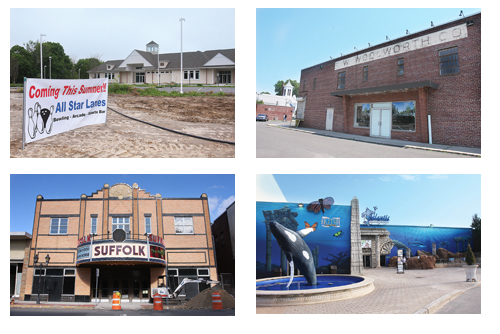Special Report: What’s the cost of IDA tax breaks?

Ten seconds. That was how long Riverhead school board president Ann Cotten-DeGrasse knelt in silence in Town Hall, after bringing her head down to her fist in prayer. For those in the room who didn’t know, she was Tebowing, or imitating the outwardly religious football player Tim Tebow. (It was sort of a craze at the time.)
She explained at the January 2012 Industrial Development Agency meeting that she was praying for the school district, which she described as being in “dire straits” because of the state’s tax cap law. She objected to the IDA’s depriving the school district of any additional tax revenues. On the agenda that night, specifically, were tax abatements for a bowling alley in town that was already mostly built.
A month later, the alley abatements were approved 3-0, with one IDA board member absent and another, then a newcomer, abstaining.
Ms. Cotten-DeGrasse wasn’t the first school official to attend a Riverhead IDA hearing in protest, claiming the Riverhead School District can’t afford to be short-changed because of abatements granted by the public benefit corporation. But the quiet drama of her display certainly attracted the most attention.
So how much, exactly, does the IDA give away in property tax exemptions each year?
The News-Review set out to find out.
According to numbers compiled from town records, 18 properties in Riverhead Town will receive some type of break on property taxes through the IDA in 2014. On those 18 parcels sit the Suffolk Theater, Hilton Garden Inn, All Star bowling center and the Long Island Aquarium & Exhibition Center, as well as office space and residential apartment complexes. The list also includes one apartment complex that’s nearing the end of a 40-year tax abatement that was actually granted by the Town Board, not the IDA, in 1981.
No big retail stores currently receive tax abatements through the IDA, according to the records.
“The biggest misconception about the IDA is that everyone thinks all these box stores on Route 58 are getting tax breaks,” said IDA executive director Tracy Stark-James.
IDA tax exemptions apply only to school, town, county and fire district taxes and usually apply only to the value of the improvements made to a property, so the exemptions generally will not lower the amount of taxes already being paid by a landowner. Some critics say exemptions are given to projects that would have come to town even without them and that property tax shortfalls are then made up by other landowners.
According to the town tax receiver’s office, the 18 properties with current IDA exemptions will pay a total of $419,401 in 2014 for taxes that are not subject to those exemptions, such as water, sewer, library and ambulance tax. Without any IDA exemptions, those properties would pay a total of $3.4 million in taxes.
But that number doesn’t tell the whole story, says Ms. Stark-James.
Those properties will also pay a total of $1.3 million in payments in lieu of taxes, or PILOTs, which reflect the exemptions granted to the school, town, county and fire district taxes. (In these cases, the PILOT payments reflect the reduced tax bills, along with the taxes charged to the properties as they were before they were developed or improved.)

When including PILOTs, the owners of those 18 properties will be contributing a total of $1.72 million in taxes in 2014. That would put the total value of the property tax exemptions being granted by the IDA — in other words, the amount that would have been collected without the breaks — at $1.68 million for 2014.
RELATED EDITORIAL: A NEW YEAR’S RESOLUTION FOR THE RIVERHEAD IDA
With 15,156 taxable parcels in Riverhead Town, spreading that shortfall among other property owners would break down to about $111 per tax bill issued — though, of course, that figure is just an average and does not reflect the true cost to the owner of, say, a $300,000 home.
MORE NUMBERS
The IDA was established in 1980 by an act of New York State at the request of the Town Board. The goal was to jump-start economic development in what was then a town beginning to transition from a relatively small farming community with small business centers to a more traditional suburb looking to attract more local commerce.
Its mission, according to riverheadida.org, is to “attract new businesses” and “help existing businesses expand their operations and remain in Riverhead.”
The IDA’s standard tax exemption is a 10-year abatement that starts with 50 percent discount of what a new tax bill would be on the improved value of a property. That tax discount then declines by 5 percent each year.
But the IDA board has the discretion to grant different exemptions for different projects.
For example, an exemption for Doctors Path Apartments, a subsidized Section 8 housing complex, was originally granted by the Town Board and is now overseen by the IDA. The apartments, which provide housing for low-income residents, received a 40-year tax abatement that began in 1981. It will pay a total of $38,218 in property taxes, including the payments in lieu of taxes, in 2014.
East Main Street’s Hyatt Hotel and Long Island Aquarium & Exhibition Center received a 10-year extension of an original 10-year abatement the aquarium, then known as Atlantis Marine World, was granted in 1999. The abatement is for 100 percent of the value of improvements to the property for school, town, county and fire taxes.
Despite this, the property still generated $299,885 in property taxes, including the PILOT, in 2014.
Without the exemptions, its 2014 property tax bill would be just over $1 million.
The Summerwind Square affordable apartments and retail project downtown also received a 100 percent abatement for 10 years. The Summerwind owners still must pay $25,418 in taxes for 2014, a figure that includes the PILOT. At full assessment, the four-story building’s 2014 tax bill would be $111,556.
Ms. Stark-James says it’s not entirely fair to compare would-be taxes to actual, current payments, because without the IDA incentives, some projects would never have been built here in the first place. No improvements means no additional tax benefits, period, she said.
The total assessed value of the 18 current IDA properties prior to their IDA incentives was $2.39 million. The current assessed value of those same projects is $18.3 million, Ms. Stark-James said.
Assessed value in Riverhead is 15.9 percent of market value, which means the combined market value of those properties increased from $1.4 million to $114.48 million.
Other projects that were approved for IDA tax exemptions in 2013, but too late to get exemptions in 2014, include the 21st Century Oncology building on Route 58, Green Island Steel at EPCAL and Allied Building Supply on Edwards Avenue.
Hampton Jitney’s exemptions don’t kick in until the building on Edwards Avenue has a certificate of occupancy, so its PILOT payments are the same as if it paid full taxes, Ms. Stark-James said.
The PILOT figures, for one, are not listed anywhere in town tax rolls and had to be supplied to the newspaper by the IDA itself.
A 2012 report from state Comptroller Thomas DiNapoli called for each the more than 111 local IDAs across the state to publish annual “report cards” including detailed information on job creation and retention, tax exemptions granted, PILOT amounts paid for each project assisted by an IDA and whether the projects’ job creation goals were met.
The comptroller proposed requiring IDAs to include a “clawback” provision to allow them to recapture benefits if goals are not met.
PROJECTS CURRENTLY RECEIVING IDA TAX BREAKS
Doctor’s Path Apartments • John Wesley Village II • John Wesley III • The All Star • Neefus-Stype Insurance • Long Island Vitreoretinal Consultants • East End Veterinary Clinic • Hampton Jitney • Hilton Garden Inn • Peconic Management Group (715 Roanoke Ave.) • Dark Horse Restaurant • Summerwind Square Apartments • Woolworth building • Suffolk Theater • Mirah Max building (Blue Duck Bakery/Ralph’s/Papa John’s) • Long Island Aquarium & Exhibition Center and Hyatt Hotel • Island International • Riverhead Building Supply
THE CRITICS
The IDA also came under criticism in the fall from Anthony Coates, who ran a Republican primary for a town council seat and lost.
“Right now, there’s nothing anyone can point to that ensures that it’s a net gain for the residents,” he said. “I believe every transaction the IDA makes should be done in a hard-and-fast spreadsheet format so that the residents of the town know that the town is deriving a value in giving the tax break.”
Mr. Coates also expressed concern that “we may be giving breaks to people who were already coming here.”

He used the Allied Building Products project as an example, saying the company had a site plan application identifying the building as being intended for Allied Building Products before it even went before the IDA.
Mr. Coates also charged that the IDA’s budget, which includes funding for the executive director’s salary, is troublesome in that it is funded through fees paid by the companies it helps.
He believes this is a flaw in that it creates an incentive for the IDA to give tax breaks.
Ms. Stark-James said the IDA has indeed had to turn away companies that don’t meet IDA criteria for exemptions, scoffing at the notion that any other considerations apply other than what’s good for the town’s economic health.
“A lot of criteria go into deciding which projects to assist,” she said, noting that decisions on which projects receive helped are made by the IDA board, of which she is not a member. “The IDA looks at applications from an economic development standard and from what is for the betterment of the community,” Ms. Stark-James said.
And while job creation and quality is one criterion board members use, she said, they can’t just look for high-end jobs.
“You have to have a diversity of jobs,” she said.
For her part, Ms. Cotten-DeGrasse said she now believes the IDA has begun to listen to her and others concerned about how lost funding affects local schools, as some of the abatements granted recently have been for fewer years than previously granted, such as with the aquarium and Summerwind projects.
“I don’t think the average person in town understands the ramifications of what [huge tax abatements] are doing,” Ms. Cotten-DeGrasse said. “Every time you take something off the tax rolls, the rest of the community is picking up the freight, and blaming it on the schools.”
She said she doesn’t have a problem with helping small businesses locate in town.
“What I have a problem with is when these developers go to the banks, and the banks tell them they have to exhaust all their resources before they will give them a mortgage,” she said.
One project she spoke against was the new 21st Century Oncology facility being built at the former PC Richard site on Route 58.
“That particular company has offices in 27 states and five foreign countries and 3,000 employees,” she said. “What do they need our little IDA exemption for?”
BANKS & BENEFITS
Lee Browning, who received IDA tax exemptions in 2007 for the 114-room Hilton Garden Inn on Route 58, said the decision to seek IDA breaks wasn’t his, it was his bank’s.
“The bank wanted it as a requirement to give the loan,” he said. “So, no IDA, no mortgage. It’s pretty simple.”
Mr. Browning plans to file a new site plan for a second hotel, a 140-room Marriott Residence Inn, right next to the Hilton Garden Inn.
And he plans to seek IDA exemptions for that project as well.
“It’s an extremely important tool to us but, more importantly, the banks look for it,” Mr. Browning said. “It reduces my debt and it makes them more secure. And the public gets the benefit of the ripple of the hotel. Think about how many tourists that hotel brings in per year. Wine Country, Splish Splash, downtown Riverhead. We bring in expendable money.”
He said that, according to Marriott, the amount of people spend on rooms will multiply by 2.5 times in the local economy.
“So if my rate is $150, two and a half times that is going to be spent in local restaurants, coffee shops, wine tours, delis and gas stations,” he said. “That’s a lot of money.”
The IDA exemption the Hilton Garden Inn received in 2007 was for 10 years and began as a 50 percent tax exemption on the assessed improvements to the property, declining by 5 percent each year.
Mr. Browning said his current property taxes are still more than $200,000 annually.
The 7 Bus, formerly known as Bolt Bus, also uses his parking lot at the Hilton Garden Inn, and brings hundreds of tourists out from the city, he said.
The Hilton employs 40 people, all local, and 35 of them full-time, Mr. Browning said. The Marriott will employ another 60 people, he said.
In the long beleaguered downtown area, Michael Butler’s company is currently renovating the former Woolworth building, which has sat mostly empty since 1997, into a gym, small stores and 19 affordable apartments.
His project was also granted tax exemptions by the Riverhead IDA.
Mr. Butler called the property tax breaks “one of the incentives to coming to downtown Riverhead and taking a risk.”
It helped that he saw others taking risks, albeit with the help of tax breaks.
Mr. Butler said projects like the aquarium, which also received IDA benefits, influenced his decision to come to Riverhead.
Getting the tax breaks toward the beginning of the project is important, he said.
“The initial years of your project is when you have a lot of money going into it, and one of the major costs of operating is real estate taxes, so it is helpful to have that reduced, so you can put your funds into the building,” he said.
Riverhead Supervisor Sean Walter, who — along with the rest of the Town Board — appoints IDA board members, said he believes all IDA benefits should be concentrated on EPCAL and downtown Riverhead and that projects in areas like Route 58 should no longer get IDA benefits.
“They’ve been pretty good about it,” Mr. Walter said, indicating that not a lot of projects on Route 58 have gotten exemptions.
The Hilton Garden Inn, 21st Century Oncology and the All Star are the only current IDA projects on what’s considered Route 58, though the All Star is technically on Route 25. The Holiday Inn Express on Route 58 also received IDA benefits in 2009, but they have since expired.
And although much of the bowling alley was already built when Ms. Cotten-DeGrasse dropped to a knee in prayer in early 2012, that work had been undertaken by a previous owner and sat unfinished for more than a year. The project was later foreclosed on and Main Road Holdings, headed by developer Jeffrey Rimland, bought the mortgage. The previous property owners had received IDA tax breaks but never completed the paperwork required to get them enacted, Mr. Rimland and IDA officials said at the time.
Main Road Holdings got slightly less than the standard IDA exemptions, receiving a seven-year property tax abatement that gives the project a 50 percent exemption on the value of property improvements for each of the first three years and then decreases that exemption by 5 percent a year for the next four years.
The IDA also offers assistance in areas other than property taxes, such as exemptions on mortgage tax and sales tax for materials used in construction. In addition, it has offered financing assistance to some projects that already are tax exempt, such as Peconic Bay Medical Center and the Riverhead Charter School.
When Tanger Outlets was built, Ms. Stark-James said, it received IDA assistance for sales tax only, and is now the town’s highest taxpayer, generating more than $4 million a year in taxes.








